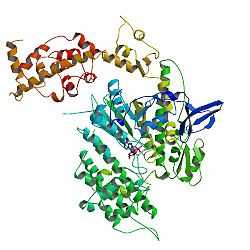MYL6
Myosin light polypeptide 6 is a protein that in humans is encoded by the MYL6 gene.[1][2][3][4]
Myosin is a hexameric ATPase cellular motor protein. It is composed of two heavy chains, two nonphosphorylatable alkali light chains, and two phosphorylatable regulatory light chains. This gene encodes a myosin alkali light chain that is expressed in smooth muscle and non-muscle tissues. Genomic sequences representing several pseudogenes have been described and two transcript variants encoding different isoforms have been identified for this gene.[4]
References
- ↑ Bora PS, Bora NS, Wu X, Kaplan HJ, Lange LG (Jun 1994). "Molecular cloning, sequencing, and characterization of smooth muscle myosin alkali light chain from human eye cDNA: homology with myocardial fatty acid ethyl ester synthase-III cDNA". Genomics 19 (1): 186–8. doi:10.1006/geno.1994.1041. PMID 8188229.
- ↑ Hailstones DL, Gunning PW (Mar 1990). "Characterization of human myosin light chains 1sa and 3nm: implications for isoform evolution and function". Mol Cell Biol 10 (3): 1095–104. PMC 360973. PMID 2304459.
- ↑ Lenz S, Lohse P, Seidel U, Arnold HH (Jun 1989). "The alkali light chains of human smooth and nonmuscle myosins are encoded by a single gene. Tissue-specific expression by alternative splicing pathways". J Biol Chem 264 (15): 9009–15. PMID 2722814.
- ↑ 4.0 4.1 "Entrez Gene: MYL6 myosin, light chain 6, alkali, smooth muscle and non-muscle".
Further reading
- Komiyama M, Soldati T, von Arx P, Perriard JC (1997). "The intracompartmental sorting of myosin alkali light chain isoproteins reflects the sequence of developmental expression as determined by double epitope-tagging competition". J. Cell. Sci. 109 (8): 2089–99. PMID 8856505.
- Watanabe M, Kohri M, Takaishi M et al. (2001). "Molecular cloning and sequencing of myosin light chains in human megakaryoblastic leukemia cells". Journal of smooth muscle research = Nihon Heikatsukin Gakkai kikanshi 37 (1): 25–38. doi:10.1540/jsmr.37.25. PMID 11436981.
- Strausberg RL, Feingold EA, Grouse LH et al. (2003). "Generation and initial analysis of more than 15,000 full-length human and mouse cDNA sequences". Proc. Natl. Acad. Sci. U.S.A. 99 (26): 16899–903. doi:10.1073/pnas.242603899. PMC 139241. PMID 12477932.
- Bouwmeester T, Bauch A, Ruffner H et al. (2004). "A physical and functional map of the human TNF-alpha/NF-kappa B signal transduction pathway". Nat. Cell Biol. 6 (2): 97–105. doi:10.1038/ncb1086. PMID 14743216.
- Brandenberger R, Wei H, Zhang S et al. (2005). "Transcriptome characterization elucidates signaling networks that control human ES cell growth and differentiation". Nat. Biotechnol. 22 (6): 707–16. doi:10.1038/nbt971. PMID 15146197.
- Gerhard DS, Wagner L, Feingold EA et al. (2004). "The Status, Quality, and Expansion of the NIH Full-Length cDNA Project: The Mammalian Gene Collection (MGC)". Genome Res. 14 (10B): 2121–7. doi:10.1101/gr.2596504. PMC 528928. PMID 15489334.
- Rual JF, Venkatesan K, Hao T et al. (2005). "Towards a proteome-scale map of the human protein-protein interaction network". Nature 437 (7062): 1173–8. doi:10.1038/nature04209. PMID 16189514.
- Fu ZY, Xie BT, Ma YT, Gong ZX (2006). "Preparation of monoclonal antibodies against human ventricular myosin light chain 1 (HVMLC1) for functional studies". Acta Biochim. Biophys. Sin. (Shanghai) 38 (9): 625–32. doi:10.1111/j.1745-7270.2006.00203.x. PMID 16953301.
| |||||||||||||




